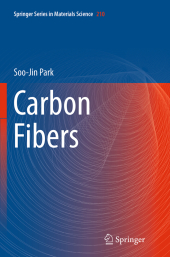 Neuerscheinungen 2016Stand: 2020-02-01 |
Schnellsuche
ISBN/Stichwort/Autor
|
Herderstraße 10
10625 Berlin
Tel.: 030 315 714 16
Fax 030 315 714 14
info@buchspektrum.de |

Soo-Jin Park
Carbon Fibers
Softcover reprint of the original 1st ed. 2015. 2016. xi, 330 S. 239 SW-Abb., 46 Tabellen. 235 mm
Verlag/Jahr: SPRINGER NETHERLANDS; SPRINGER 2016
ISBN: 9402403795 (9402403795)
Neue ISBN: 978-9402403794 (9789402403794)
Preis und Lieferzeit: Bitte klicken
This book contains eight chapters that discuss the manufacturing methods, surface treatment, composite interfaces, microstructure-property relationships with underlying fundamental physical and mechanical principles, and applications of carbon fibers and their composites.
Recently, carbon-based materials have received much attention for their many potential applications. The carbon fibers are very strong, stiff, and lightweight, enabling the carbon materials to deliver improved performance in several applications such as aerospace, sports, automotive, wind energy, oil and gas, infrastructure, defense, and semiconductors. However, the use of carbon fibers in cost-sensitive, high-volume industrial applications is limited because of their relatively high costs. However, its production is expected to increase because of its widespread use in high-volume industrial applications; therefore, the methods used for manufacturing carbon fibers and carbon-fiber-reinforced composites and their structures and characteristics need to be investigated.
Chapter 1 History and Structure of Carbon Fibers.
1.1 Introduction. 1.2 Origin and History of Carbon Fibers. 1.3 Definition of Carbon Fibers. 1.4 Classification of Carbon Fibers. 1.5 Structure of Carbon Fibers. 1.6 State of Carbon Fiber Industry. 1.7 Summary.
Chapter 2 Precursors and Manufacturing of Carbon Fibers.
2.1 Introduction. 2.2 Acrylic Precursors. 2.3 Cellulosic Precursors. 2.4 Pitch Precursors. 2.5 Other Forms of Precursors. 2.6 Summary. References.
Chapter 3 Matrices for Carbon Fiber Composites.
3.1 Thermosetting Resins. 3.2 Thermoplastic Resins. References.
Chapter 4 Surface Treatment and Sizing of Carbon Fibers.
4.1 Introduction. 4.2 Oxidation of Carbon Fibers. 4.3 Plasma Treatment. 4.4 Other Surface Modification Methods. 4.5 Sizing. References.
Chapter 5 Testing of Carbon Fibers and Their Composites.
5.1 Introduction. 5.2 Evaluation of Carbon Fibers. 5.3 Evaluation of Composites. 5.4 Relationship between Surface and Interfacial Properties in Composites. References.
Chapter 6 Manufacture of Carbon Fiber Composites.
6.1 Selection of Manufacturing Process for Carbon Fiber Composites. 6.2 Type of Reinforcement. 6.3 Type of Matrix. 6.4 Open Molding Process. 6.5 Closed Molding Process. 6.6 Understanding Manufacturing Process of Composites. 6.7 Summary. References.
Chapter 7 Recent Uses of Carbon Fibers.
7.1 Introduction. 7.2 Applications of Virgin Carbon Fibers. 7.3 Applications of Carbon-Fiber-Reinforced Composites. 7.4 Applications of Carbon/Carbon Composites. References.
Chapter 8 Carbon Fibers and Their Composites.
8.1 Low-Cost Production Technique of Carbon Fibers for General Industries. 8.2 Thin Carbon Fibers for Extreme Industries. 8.3 Functional Carbon Fibers for Smart Composites. References.
Index.
Soo-Jin PARK is a professor in the department of chemistry at Inha University and an Editor-in-Chief of Carbon Letters. He received his Ph.D. in 1992 carried out under the supervision of Prof. Jean-Baptiste DONNET from Centre National de la Recherche Scientifique (CNRS), France. His research interests include carbon materials for energy conversion and storage, curing catalysts and polymer-carbon composites, green adsorption device with porous carbons, and so on.


